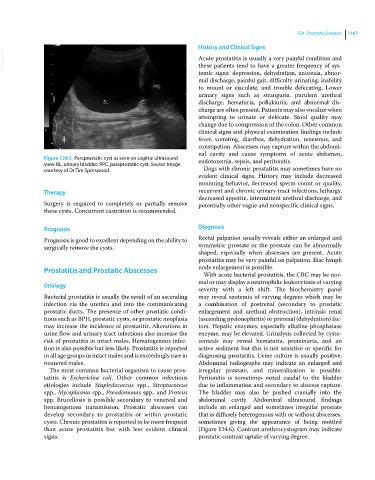Page 1223 - Clinical Small Animal Internal Medicine
P. 1223
124 Prostatic Diseases 1161
History and Clinical Signs
VetBooks.ir Acute prostatitis is usually a very painful condition and
these patients tend to have a greater frequency of sys-
temic signs: depression, dehydration, anorexia, abnor-
mal discharge, painful gait, difficulty urinating, inability
to mount or ejaculate, and trouble defecating. Lower
urinary signs such as stranguria, purulent urethral
discharge, hematuria, pollakiuria, and abnormal dis-
charge are often present. Patients may also vocalize when
attempting to urinate or defecate. Stool quality may
change due to compression of the colon. Other common
clinical signs and physical examination findings include
fever, vomiting, diarrhea, dehydration, tenesmus, and
constipation. Abscesses may rupture within the abdomi-
nal cavity and cause symptoms of acute abdomen,
Figure 124.5 Paraprostatic cyst as seen on sagittal ultrasound endotoxemia, sepsis, and peritonitis.
view. BL, urinary bladder; PPC, paraprostatic cyst. Source: Image
courtesy of Dr Tim Spotswood. Dogs with chronic prostatitis may sometimes have no
evident clinical signs. History may include decreased
mounting behavior, decreased sperm count or quality,
Therapy recurrent and chronic urinary tract infections, lethargy,
decreased appetite, intermittent urethral discharge, and
Surgery is required to completely or partially remove potentially other vague and nonspecific clinical signs.
these cysts. Concurrent castration is recommended.
Prognosis Diagnosis
Prognosis is good to excellent depending on the ability to Rectal palpation usually reveals either an enlarged and
surgically remove the cysts. symmetric prostate or the prostate can be abnormally
shaped, especially when abscesses are present. Acute
prostatitis may be very painful on palpation. Iliac lymph
Prostatitis and Prostatic Abscesses node enlargement is possible.
With acute bacterial prostatitis, the CBC may be nor-
mal or may display a neutrophilic leukocytosis of varying
Etiology
severity with a left shift. The biochemistry panel
Bacterial prostatitis is usually the result of an ascending may reveal azotemia of varying degrees which may be
infection via the urethra and into the communicating a combination of postrenal (secondary to prostatic
prostatic ducts. The presence of other prostatic condi- enlargement and urethral obstruction), intrinsic renal
tions such as BPH, prostatic cysts, or prostatic neoplasia (ascending pyelonephritis) or prerenal (dehydration) fac-
may increase the incidence of prostatitis. Alterations in tors. Hepatic enzymes, especially alkaline phosphatase
urine flow and urinary tract infections also increase the enzyme, may be elevated. Urinalysis collected by cysto-
risk of prostatitis in intact males. Hematogenous infec- centesis may reveal hematuria, proteinuria, and an
tion is also possible but less likely. Prostatitis is reported active sediment but this is not sensitive or specific for
in all age groups in intact males and is exceedingly rare in diagnosing prostatitis. Urine culture is usually positive.
neutered males. Abdominal radiographs may indicate an enlarged and
The most common bacterial organism to cause pros- irregular prostate, and mineralization is possible.
tatitis is Escherichia coli. Other common infectious Peritonitis is sometimes noted caudal to the bladder
etiologies include Staphylococcus spp., Streptococcus due to inflammation and secondary to abscess rupture.
spp., Mycoplasma spp., Pseudomonas spp., and Proteus The bladder may also be pushed cranially into the
spp. Brucellosis is possible secondary to venereal and abdominal cavity. Abdominal ultrasound findings
hematogenous transmission. Prostatic abscesses can include an enlarged and sometimes irregular prostate
develop secondary to prostatitis or within prostatic that is diffusely heterogenous with or without abscesses,
cysts. Chronic prostatitis is reported to be more frequent sometimes giving the appearance of being mottled
than acute prostatitis but with less evident clinical (Figure 124.6). Contrast urethrocystogram may indicate
signs. prostatic contrast uptake of varying degree.

